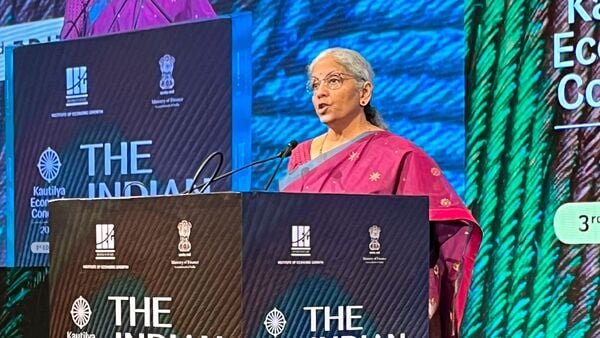New Delhi: India’s youth and rising middle class will drive a surge in consumption, innovation, and investment, with per capita income projected to increase by $2,000 in five years, finance minister Nirmala Sitharaman said on Friday.
India’s young population, with 43% under 24, is yet to fully explore its consumption behaviour, stated Sitharaman during the third Kautilya Economic Conclave. “There will be an organic growth in consumption as they become full fledged consumers. Simultaneously, a rising middle class will pave the way for strong consumption, inflow of foreign investment and a vibrant marketplace,” she said.
Sitharaman highlighted India’s leap from the tenth to the fifth largest economy within five years, maintaining high growth rates and stable inflation.
She said economic policies have doubled per capita income in a short span, substantially improving the living standards of Indians.
“While it took us 75 years to reach a per capita income of $2,730, as per IMF projections, it will take only five years to add another $2,000. The upcoming decades will see the steepest rise in living standards for the common man, truly making it a period-defining era for an Indian to live in,” she said.
This rapid rise is accompanied by declining inequality, as the Gini coefficient declined in both rural and urban areas. The Gini coefficient, also referred to as the Gini index or ratio, is a statistical tool used to measure the extent of income, wealth, or consumption inequality within a population or country.
“Expect these improvements to continue as the effects of the last 10 years of economic and structural reforms manifest more thoroughly in the data in the coming years, as the covid shock fades away from the economy,” she said.
Fiscal discipline
The finance minister also emphasised government’s commitment to fiscal discipline, “aided by buoyant revenue generation, restrained revenue expenditure growth and healthy economic activity.”
“The fiscal deficit is estimated to decline further from 5.6% of GDP in FY24 to 4.9% in FY25. The commitment to fiscal discipline will not only help keep bond yields in check, but will translate to lower economy-wide borrowing costs,” Sitharaman said.
“The quality of government expenditure continues to improve. Capital expenditures budgeted to grow by 17.1% to ₹11.1 lakh crores this fiscal. This amounts to 3.4% of GDP in FY25. Additionally, a larger proportion of fiscal deficit is now accounted for by capital outlays, indicating an increasingly investment oriented deficit financing,” she said.
“The decline in commodity prices has facilitated the lowering of the budget allocation for subsidies on fertilizer and fuel. This has contributed to restraining the growth in revenue expenditure, which is estimated to increase by 6.2% year on year, to ensure policy continuity, the bedrock of sustained growth,” she added.
The minister also said India’s innovation ability will mature and improve over the coming decades.
(Press the bell 🔔 Icon, for all latest updates)






